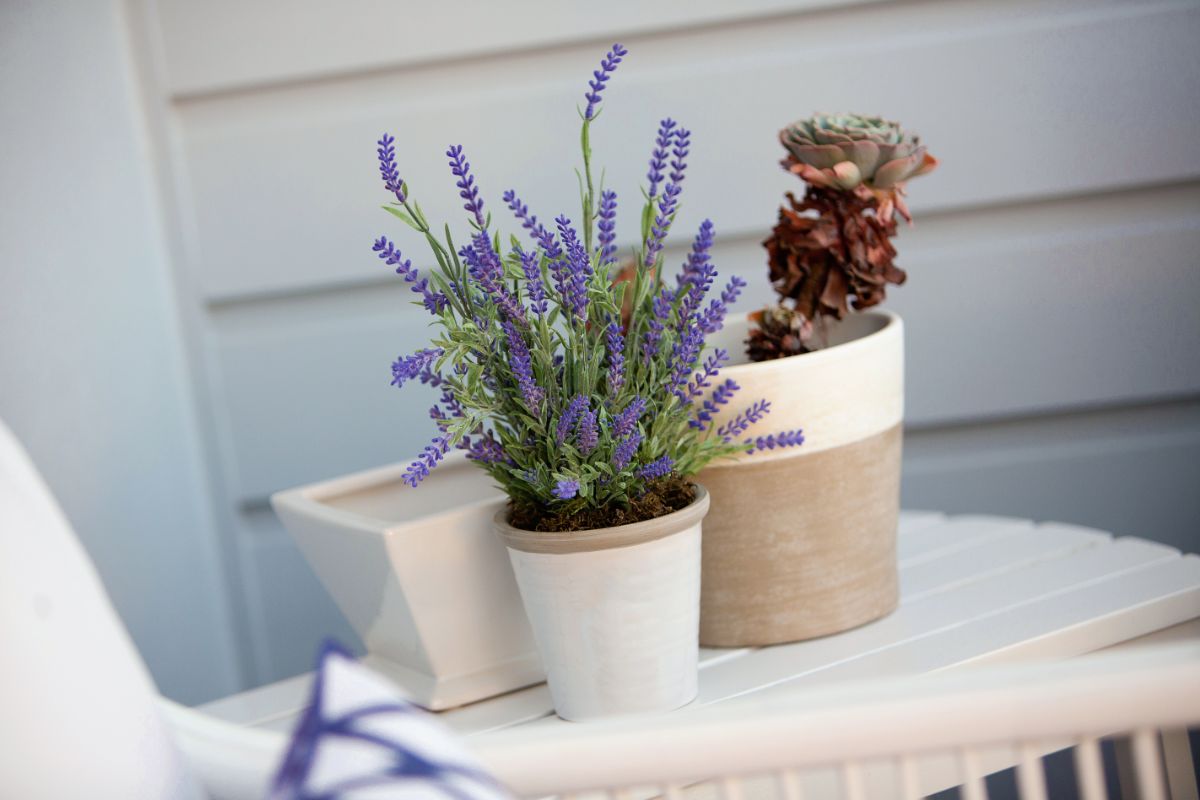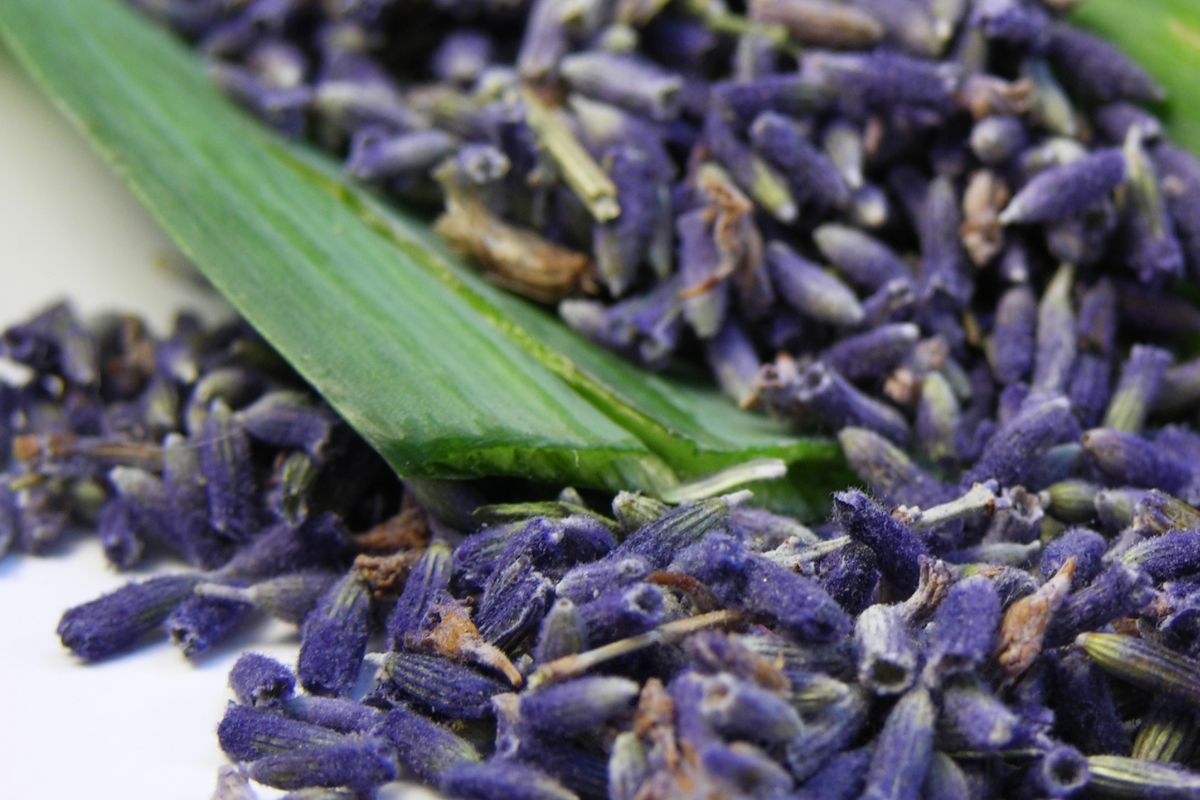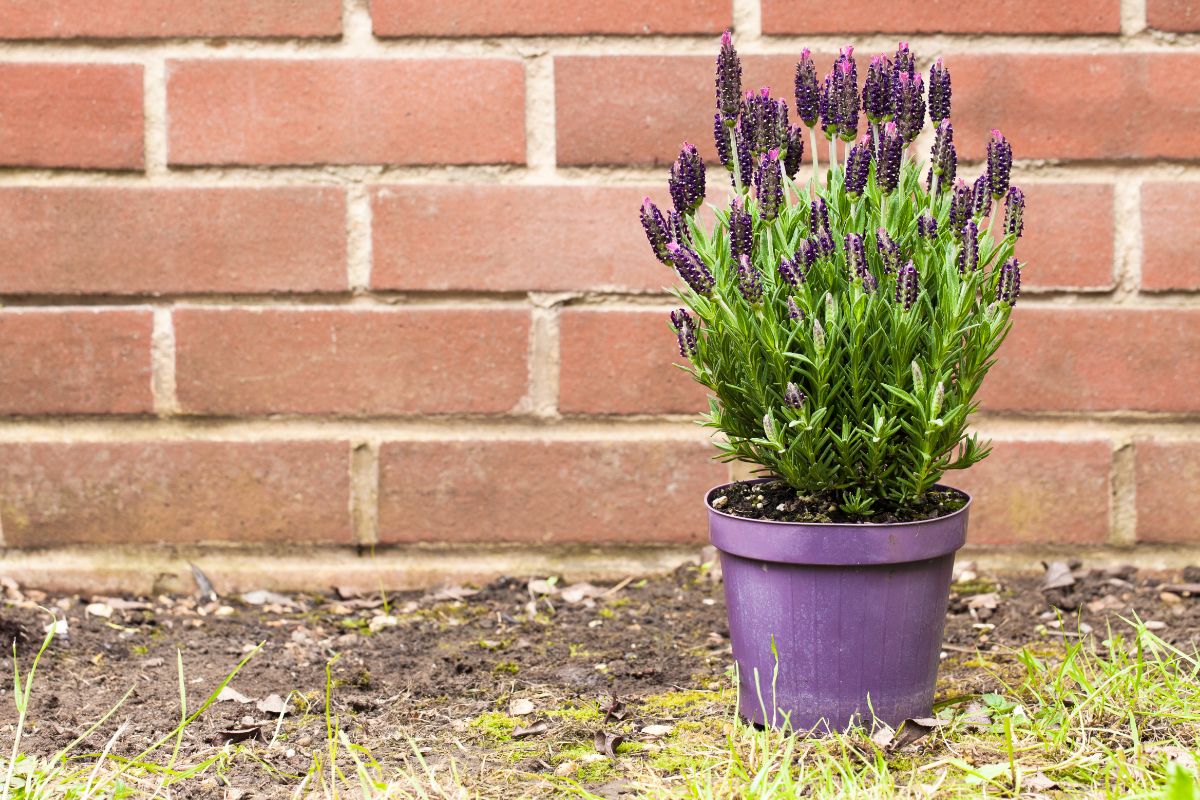As the world grows increasingly urbanized, many people are turning to indoor gardening and growing lavender as a way to connect with nature and beautify their homes.

But how can one grow lavender from seeds indoors? In this article, we will answer this question as we explore the fascinating world of indoor lavender gardening!
What Are The Benefits Of Growing Lavender Indoors?
One of the most popular plants for indoor gardening is lavender. This fragrant and beautiful herb has been prized for centuries for its calming properties and delightful scent.
So, what are the benefits of growing it indoors? Let’s have a look at the top ones:
Aromatherapeutic
The calming aroma of lavender is well-known for its soothing and relaxing properties.
Growing lavender indoors provides a constant source of this lovely scent, creating a tranquil and calming atmosphere in your home.
The aroma of lavender has also been shown to reduce anxiety and promote relaxation, making it an excellent addition to your indoor space.
Beautiful And Decorative
Lavender is a stunning plant with lovely purple flowers that will add a touch of elegance to any indoor space.
Its delicate blooms and lovely scent make it a popular choice for decorative purposes, and it can be used to create beautiful arrangements or to add some greenery to your home’s decor.
Healthy
Lavender has been used for centuries for its medicinal properties, and growing lavender indoors can provide a range of health benefits.
The aroma of lavender has been shown to help reduce headaches, promote restful sleep, and ease symptoms of depression and anxiety.
Easy To Grow
Lavender is a hardy plant that is relatively easy to grow, making it a perfect choice for novice gardeners.
It requires minimal care and attention, and as long as it has access to plenty of sunlight and well-draining soil, it will thrive indoors.
How To Choose The Right Lavender Seeds
When it comes to growing lavender from seeds indoors, choosing the right type of seeds is essential, and understanding the different types of lavender seeds and their characteristics will help you select the best variety for your indoor garden.
Types Of Lavender Seeds
There are many different types of lavender seeds available, each with its unique features and growing requirements.
The two main categories of lavender are English Lavender (Lavandula angustifolia) and French Lavender (Lavandula stoechas).
- English lavender is the most common variety and is known for its soothing scent and delicate flowers.
- French lavender, on the other hand, has a more pungent aroma and is often used for cooking and medicinal purposes.
Within these two categories, there are also many different cultivars, each with its unique characteristics.
Some varieties are known for their larger flowers, while others are more compact or have different shades of purple.
Factors To Consider When Choosing Lavender Seeds

When choosing lavender seeds for your indoor garden, there are several factors to consider to ensure the success of your plants.
Seed Viability
When purchasing lavender seeds, it is important to consider the seed’s viability. Lavender seeds are viable for about one year, so it is crucial to buy fresh seeds for optimal germination rates.
Growing Conditions
Moreover, you also need to think about the growing conditions in your indoor space, including the amount of sunlight and humidity.
Lavender seeds require plenty of sunlight to germinate and grow, so it is crucial to select a variety that can thrive in the lighting conditions available in your home.
Seed Type And Cultivar
As we discussed earlier, there are many different types and cultivars of lavender seeds available, so you also need to take into account your desired outcome when selecting your seeds, such as whether you want larger flowers or a particular shade of purple.
Germination Rate
Different lavender seeds have varying germination rates, which refers to the percentage of seeds that will sprout and grow.
Therefore, another thing you need to consider is the germination rate when selecting your lavender seeds to ensure a higher success rate in growing your plants.
Where To Buy Lavender Seeds
When purchasing lavender seeds, it is important to ensure that you are buying from a reputable source. Some good options are:
Local Nurseries And Garden Centers
Local nurseries and garden centers are a great place to start when looking for lavender seeds since they often carry a variety of seeds and can offer expert advice on growing lavender indoors.
This makes them a particularly great option if you prefer to see the seeds in person before making a purchase.
Online Retailers
In recent years, online retailers have become a popular option for purchasing lavender seeds. Many reputable online retailers offer a variety of lavender seed options.
This is a particularly convenient option as you can easily compare prices and varieties from the comfort of your own home.
Seed Exchanges And Swaps
Seed exchanges and swaps are a fun and unique option for acquiring lavender seeds and these events allow gardeners to exchange seeds with each other, often for free or at a very low cost, which also makes them a great way to meet other gardeners and acquire seeds that may be hard to find elsewhere.
Specialty Seed Companies
If you are looking for a specific type or cultivar of lavender seed, a specialty seed company may be the best option for you as these companies specialize in offering unique and hard-to-find seed varieties.
How To Grow Lavender From Seeds Indoors
To grow your lavender from seeds indoors, here are the steps you need to follow:
Prepare The Soil For Your Lavender Seeds
Of course, we cannot stress enough how important soil preparation is, and we have some tips on how you can create the ideal growing medium for your lavender seeds.
Choose The Right Soil Mix
Lavender plants thrive in well-draining soil that is not too rich in nutrients and a soil mix that is high in organic matter, such as compost or peat moss, can hold too much moisture and lead to root rot.
We highly recommend you use a soil mix that contains a combination of potting soil, sand, and perlite. This mix will provide good drainage while still retaining some moisture for the seeds to germinate.
Add Fertilizer
While lavender does not require a lot of nutrients to grow, adding a small amount of fertilizer can help support healthy growth.
Therefore, it is best to use a balanced, slow-release fertilizer that is low in nitrogen. Avoid using high-nitrogen fertilizers, as they can promote excessive foliage growth at the expense of flower production.
Sterilize The Soil
Sterilizing the soil before planting your lavender seeds can help prevent the growth of harmful pathogens and pests.
To sterilize the soil, spread it out in a thin layer on a baking sheet and bake it in the oven at 180-200°F for 30 minutes.
Alternatively, you can microwave the soil in a microwave-safe container for 90 seconds per cup of soil.
Prepare The Soil For Planting
Before planting your lavender seeds, it is important to moisten the soil mix to ensure good seed-to-soil contact.
Fill your container with the soil mix, leaving about ½ inch of space at the top, and then gently press the soil to firm it.
Then water the soil thoroughly and allow the container to drain before planting your lavender seeds.
Prepare The Space For Your Lavender Seeds
Lighting
Lavender requires plenty of sunlight to grow, so it’s important to provide adequate lighting for your indoor lavender plants.
If you have a south-facing window that receives at least six hours of sunlight per day, it’s an ideal location for your lavender plants.
If you don’t have access to natural sunlight, you can use artificial lighting in the form of grow lights, and make sure to place the lights close to the plants and keep them on for 12-14 hours per day.
Temperature And Humidity
Lavender plants thrive in a warm, dry environment. The ideal temperature for indoor lavender plants is between 60-70°F during the day and around 50-55°F at night.
Keep in mind that the temperature should not fluctuate too much, as this can damage the plants.
Moreover, humidity levels should be kept low to prevent mold and mildew growth, so you can always use a dehumidifier to regulate the humidity levels in your growing space.
Air Circulation
Good air circulation is crucial for the health of your indoor lavender plants.
Proper ventilation will prevent the growth of mold and mildew and also help to regulate temperature and humidity levels, so you can use a small fan to circulate the air in your growing space.
Choose The Right Container
Choosing the right container is important for the health of your lavender plants.
Make sure the container has drainage holes to prevent water from accumulating at the bottom, which can lead to root rot.
Choose a container that is slightly larger than the size of the seedling to allow room for growth. Terracotta pots are a good choice because they allow for good air circulation and drainage.
When To Plant Lavender Seeds Indoors

Timing is essential in lavender cultivation, and planting at the right time can ensure a healthy and productive plant.
The ideal time to plant lavender seeds indoors is in late winter or early spring. This timing allows for the plants to establish roots and grow sturdy stems before the warm summer months.
Lavender is a slow-growing plant, and it takes approximately two to three months for the seeds to germinate and reach transplant size.
Planting lavender seeds indoors in the fall or winter is not recommended, as these plants require ample sunlight to grow and the lack of sunlight during these months can lead to weak, spindly plants that are susceptible to pests and diseases.
Step-By-Step Guide To Planting Lavender Seeds Indoors
Step 1: Prepare The Container
Choose a container that is at least 2-3 inches deep with drainage holes. Fill the container with a well-draining potting mix that is light and fluffy. Leave about an inch of space at the top to allow for watering.
Step 2: Plant The Lavender Seeds
Sow the lavender seeds on top of the soil, spacing them approximately one inch apart. Gently press them into the soil, but do not bury them too deep. Cover the seeds lightly with soil, no more than a quarter inch deep.
Step 3: Water The Soil
Water the soil gently to ensure even moisture. Be careful not to overwater the soil, as lavender seeds do not like to be too wet. Use a spray bottle or watering can with a gentle stream to avoid disturbing the seeds.
Step 4: Cover The Container
Cover the container with plastic wrap or a humidity dome to create a greenhouse effect and keep the soil moist. This will help to create a warm and humid environment that encourages seed germination.
Step 5: Provide Proper Lighting
Place the container in a warm and sunny location or under grow lights. Lavender seeds require at least six hours of sunlight daily, so make sure the container is in a well-lit area.
If you are using grow lights, position them about 6-12 inches above the container.
Step 6: Maintain Proper Moisture Levels
Check the moisture levels regularly and water the soil when it begins to dry out. Keep the soil consistently moist but not too wet. Avoid overwatering, as this can lead to root rot and other plant diseases.
Tips For Caring For Your Lavender Seeds After Planting
Now that your seeds have been planted, it is essential to take good care of them to ensure that they grow into healthy and vibrant plants.
Here are some tips for caring for your lavender seeds after planting:
Maintain Proper Moisture Levels
As mentioned earlier, it is crucial to keep the soil consistently moist but not too wet. Avoid overwatering as this can lead to root rot and other plant diseases.
It’s also important to ensure that the soil has good drainage to prevent waterlogging.
Provide Adequate Lighting
Like we said, lavender seeds require at least six hours of sunlight daily, so make sure the container is in a well-lit area or under grow lights.
So, keep the grow lights on for 12-14 hours a day to provide the plants with the necessary light for optimal growth.
Fertilize Regularly
Once your lavender plants have grown their first true leaves, you can begin fertilizing them every two to four weeks. Use a balanced liquid fertilizer at half-strength to avoid over-fertilizing.
Prune Regularly
Prune your lavender plants regularly to encourage bushier growth and prevent them from becoming too leggy.
Pruning also helps to promote air circulation around the plant and prevents diseases.
Repot When Necessary
As your lavender plants grow, they may outgrow their containers. When this happens, it’s time to repot them into larger containers.
Ensure that the new container has good drainage and is filled with well-draining potting soil.
Watch Out For Pests And Diseases
Keep an eye out for pests such as aphids, spider mites, and whiteflies. If you notice any signs of infestation, treat the plants with insecticidal soap or neem oil.
Also, keep an eye out for signs of disease such as wilting, yellowing leaves, or moldy growth, and treat the plants accordingly
By following these tips, you can ensure that your lavender seeds grow into healthy and thriving plants, and with proper care and attention, you’ll soon have a beautiful and fragrant lavender plant to enjoy!
Transplanting Your Lavender Seedlings
Once your lavender seedlings have grown to a certain size, it may be time to transplant them into larger containers or your garden.
Here’s what you need to know about transplanting your lavender seedlings:
When To Transplant Your Lavender Seedlings
The ideal time to transplant your lavender seedlings is when they have outgrown their current container or when the weather has warmed up enough for you to transplant them into your garden.
It’s best to transplant your lavender seedlings in the spring or early summer when the weather is mild, and the risk of frost has passed.
How To Transplant Your Lavender Seedlings
Choose a new container or planting location: If you’re transplanting your lavender seedlings into a larger container, choose a container that is at least 2-3 inches larger in diameter than their current container.
Make sure the new container has good drainage holes to prevent waterlogging.
If you’re transplanting your lavender seedlings into your garden, choose a location with well-draining soil and full sun exposure.
- Prepare the soil: If you’re transplanting your lavender seedlings into a new container, fill the container with fresh potting soil. If you’re transplanting them into your garden, dig a hole that is slightly larger than the root ball and fill it with well-draining soil.
- Remove the seedling from its current container: Carefully loosen the soil around the seedling and gently lift it out of its current container. Be sure to handle the seedling by the leaves or the root ball, not the stem.
- Place the seedling into the new container or garden location: If you’re transplanting your lavender seedling into a new container, place the seedling in the center of the container and gently press the soil around it. If you’re transplanting it into your garden, place the seedling in the hole and fill the hole with soil.
- Water the seedling: Give the seedling a good drink of water to help it settle into its new home.
Caring For Your Transplanted Lavender Seedlings
After transplanting your lavender seedlings, it’s essential to continue caring for them to ensure their survival and growth.
Here are some tips for caring for your transplanted lavender seedlings:
- Water regularly: Keep the soil consistently moist but not too wet, especially in the first few weeks after transplanting. Avoid overwatering, as this can lead to root rot and other plant diseases.
- Provide adequate lighting: Lavender seedlings require at least six hours of sunlight daily, so make sure they’re in a well-lit location or under grow lights.
- Fertilize regularly: Once your lavender seedlings have grown their first true leaves, you can begin fertilizing them every two to four weeks. Use a balanced liquid fertilizer at half-strength to avoid over-fertilizing.
- Prune regularly: Prune your lavender plants regularly to promote air circulation around the plant and prevent diseases.
- Watch out for pests and diseases: Keep an eye out for pests and any signs of disease like the ones we mentioned earlier in the article.
The Bottom Line
The benefits of growing lavender indoors are numerous. Not only does it provide a lovely scent and add a touch of elegance to your home, but it also offers a range of health benefits and is easy to grow.
So, now that you know exactly how to grow your lavender indoors, why not bring some of the beauty and serenity of lavender into your home?
- Interesting Flowers That Start With A - July 21, 2023
- Interesting Flowers Beginning With H - July 21, 2023
- 14 Fascinating Flowers That Begin With C - July 20, 2023
